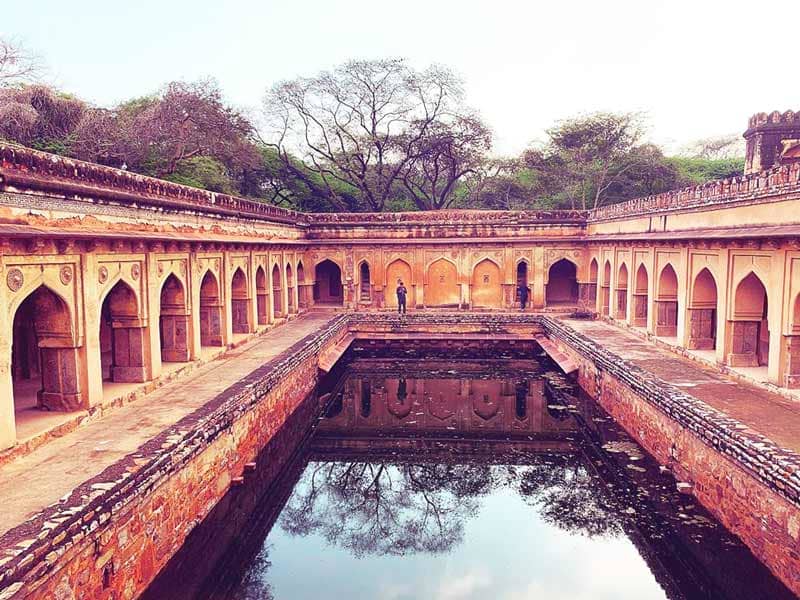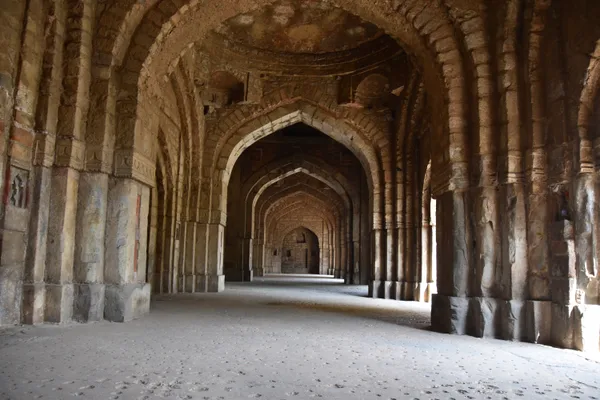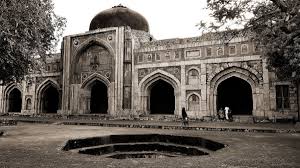A Chilling Tale of Djinns and Mughal Mystery
Nestled in Delhi’s Mehrauli Archaeological Park, just 500 meters from the iconic Qutub Minar, the Jamali Kamali Mosque and Tomb is a 16th-century gem of Mughal architecture—and one of India’s most haunted sites. While its intricate red sandstone arches and Sufi saint tombs whisper of a glorious past, the mosque is infamous for paranormal tales, particularly of djinns and shadowy apparitions. Among these, the chilling legend of The Headless Horseman of Jamali Kamali Mosque stands out, a spectral figure said to gallop through the park’s ruins on moonless nights, striking fear into those who linger after dusk. In this blog, we unravel the haunting story of the Headless Horseman, explore the mosque’s rich history, and reveal why this Delhi landmark is a must-visit for ghost hunters and history buffs alike.
Jamali Kamali: A Sufi Sanctuary with a Spooky Legacy
Built between 1528 and 1529 during the reign of Babur, the Jamali Kamali Mosque and Tomb is a Monument of National Importance, maintained by the Archaeological Survey of India (ASI). Located in Mehrauli, South Delhi, it comprises a mosque and a tomb housing Sheikh Jamali Kamboh, a Sufi saint and poet, and Kamali, his mysterious companion—possibly a disciple, lover, or wife, though their true relationship remains debated. The mosque, crafted in red sandstone with marble accents, showcases early Mughal architecture, including the jharokha style, and features a prayer hall with five arches and Koranic inscriptions. The tomb, a 7.6-meter square chamber, dazzles with blue and turquoise tiles, plastered ceilings with sunbursts, and Jamali’s poetic verses, earning it the description of a “jewel box”.
Once a vibrant Sufi shrine, the mosque is now non-functional, with Friday prayers banned to protect it from vandalism. The ASI locks the tomb and staircases, and entry is prohibited after sunset, fueling its haunted reputation. The surrounding Mehrauli Archaeological Park, dotted with ruined tombs and lush greenery, adds to the eerie ambiance, with locals warning against nighttime visits due to tales of djinns and otherworldly forces.

The Legend of the Headless Horseman
The Headless Horseman of Jamali Kamali is a lesser-known but chilling addition to the mosque’s paranormal lore, blending Delhi’s colonial and Mughal histories. According to local tales, the horseman is the restless spirit of Captain Edward Langley, a British officer stationed in Mehrauli during the 1857 Sepoy Mutiny. Langley, a cavalryman, was tasked with guarding the Qutub Minar complex against rebels. During a skirmish near the mosque, he was ambushed by mutineers, beheaded in a brutal attack, and left unburied in the park’s woods. His improper burial, coupled with the violent betrayal, is said to have bound his spirit to the area, where he roams as a headless figure astride a spectral horse.
The horseman is most often sighted on moonless nights, galloping through the Mehrauli Archaeological Park or along the mosque’s boundary. Witnesses describe a shadowy rider, cloaked in a tattered British uniform, his horse’s hooves echoing unnaturally in the silence. Some claim he charges toward intruders, vanishing before impact, while others report a chilling laugh or the sensation of being chased by an unseen force. Locals believe the horseman’s spirit is entwined with the mosque’s djinns, mythical shapeshifting beings from Islamic cosmology, who amplify his restless energy. The legend warns that those who disrespect the mosque or linger after dusk risk encountering the horseman’s wrath, with tales of invisible slaps or paralyzing fear.

Paranormal Encounters at Jamali Kamali
Jamali Kamali’s haunted reputation is fueled by numerous accounts, with the Headless Horseman adding to a tapestry of eerie experiences:
- Spectral Sightings: Visitors report seeing a headless rider near the mosque’s entrance or park trails, often accompanied by djinn-like figures or white shadows. A 2017 account describes a transparent face in photos taken near the tomb, hinting at supernatural presences.
- Unexplained Sounds: Whispers, footsteps, laughing voices, and animal growls echo in the mosque, with some hearing a horse’s gallop or a distant bugle call linked to the horseman.
- Physical Sensations: People feel invisible touches, slaps, or a gaze from behind pillars, with one visitor in 2017 reporting a gust of electric air near the tomb.
- Djinn Encounters: The mosque is said to host djinns, with tales of being followed home or sensing a presence in the tomb’s locked chamber.
- Nighttime Terrors: A 2018 Vice article recounts a night spent at Jamali Kamali, where the author felt watched and heard footsteps, though rationalized as psychological fear.
Paranormal investigators, like the Paranormal Society of India, have detected vibrations at the site using EMF meters, though no definitive evidence confirms the horseman or djinns. Locals and security guards often deny paranormal activity, attributing stories to vandalism or imagination, yet the mosque’s isolation and locked tomb fuel speculation.
Historical and Skeptical Perspectives
Jamali Kamali’s haunting is rooted in its historical significance. Sheikh Jamali, a poet under Sikandar Lodi and Mughal emperors Babur and Humayun, was buried in 1535, possibly alongside Kamali, whose identity—disciple, lover, or wife—remains a mystery. The mosque’s early Mughal design influenced later monuments, but vandalism and neglect have dimmed its glory. The 1857 Sepoy Mutiny, which saw fierce fighting in Delhi, provides a plausible backdrop for the Headless Horseman, as Mehrauli was a British stronghold.
Skeptics offer rational explanations:
- Environmental Factors: The park’s dense woods and ruins amplify sounds like wind or animals, mistaken for hooves or voices.
- Psychological Effects: The mosque’s haunted reputation, amplified by media like the TV series India’s Most Haunted, creates a placebo effect, heightening fear.
- Vandalism and Isolation: Human damage, not ghosts, has led to locked tombs and restricted access, while the mosque’s solitude fosters eerie perceptions.
- Cultural Beliefs: Islamic and Sufi traditions about djinns, combined with Delhi’s “City of Djinns” moniker, fuel supernatural tales.
- Lack of Evidence: No historical record confirms a headless soldier at Jamali Kamali, and guards report no paranormal activity, suggesting folklore over fact.
Despite skepticism, locals and visitors, like a 2017 commenter who heard footsteps with their mother, insist on unexplained phenomena, keeping the Headless Horseman’s legend alive.
Jamali Kamali Today: A Haunted Tourism Draw
Jamali Kamali remains a hidden gem in Mehrauli, open daily from 6 AM to 5 PM with free entry, though videography requires ASI permission. Accessible via Qutub Minar Metro Station (1.9 km away) or buses (routes 34, 427, 519, 534A, 715, 717), it’s 18 km from Indira Gandhi International Airport and 17 km from New Delhi Railway Station. The surrounding park offers picnic spots, but other tombs are in ruins, adding to the spooky vibe. Nearby attractions like Qutub Minar, Rajaon Ki Baoli, and Hauz Khas complement a visit.
The mosque’s haunted reputation, fueled by X posts and media, draws thrill-seekers, though ASI restrictions limit nighttime access. Its Mughal architecture and Sufi heritage attract history buffs, despite vandalism and neglect.
Why Visit Jamali Kamali? Tips for Travelers
Jamali Kamali blends Mughal grandeur, Sufi spirituality, and paranormal intrigue, making it a top Delhi destination:
- Best Time: Visit from October to February for pleasant weather, enhancing the eerie ambiance. Avoid monsoons (July–September) due to muddy trails.
- Getting There: Take the Yellow Line Metro to Qutub Minar, then an auto-rickshaw (1.9 km). Buses stop at DTC Lado Sarai or Qutub Minar. Cabs from central Delhi cost ₹230–290.
- What to See: Admire the mosque’s arches, tomb’s tiles, and park’s ruins. Pair with Qutub Minar or Rajaon Ki Baoli for a full day.
- Ghost Hunting: Bring a camera for photos (videography needs permission). Respect ASI’s sunset rule to avoid fines or risks.
- Safety: Travel in groups, as the park is isolated. Avoid touching locked areas to prevent vandalism charges.
- Cultural Respect: Honor the mosque’s Sufi legacy and local beliefs about djinns, avoiding disrespectful behavior.
Conclusion: Dare to Face the Headless Horseman?
The Headless Horseman of Jamali Kamali Mosque weaves a chilling tale of colonial tragedy, djinn lore, and Mughal mystique, transforming this Delhi landmark into a paranormal hotspot. Whether Captain Langley’s spirit gallops through Mehrauli’s ruins or the story is a myth born of the mosque’s eerie silence, its allure is undeniable. As you explore Jamali Kamali’s tiled tomb or wander the park’s trails, will you hear the horseman’s hooves or feel the djinns’ gaze? Visit before sunset to uncover its secrets—but beware what lingers in the dark.
Have you visited Jamali Kamali or heard its haunted tales? Share your experiences in the comments, and subscribe for more spooky stories from India’s haunted heritage!
Disclaimer: The Headless Horseman of Jamali Kamali Mosque is based on folklore and anecdotal reports, with no definitive evidence of paranormal activity. Approach with curiosity and respect for Delhi’s cultural and Sufi legacy.
